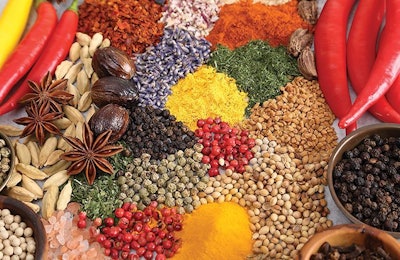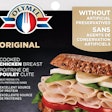
Broiler heat stress is what concerns nutritionists the most every summer, not only because birds grow slower and less efficiently, but also because their welfare and health can be severely impaired, leading to increased morbidity and mortality. Neutralizing the negative effects of heat stress is still a field that we know very little about, and most nutritionists work around this problem using a number of additives after having adjusted their formulas for the known nutrient-heat stress interactions.
Common heat stress additives include sodium bicarbonate, vitamin C, citric acid, common sodium and potassium sources, and even betaine. Such additives work at different combinations for different conditions and formulation designs, not always as effectively as one would like, but at least they seem to alleviate the problem.
Most plants found thriving under extreme climatic conditions are now recognized as sources of phenolic antioxidant compounds.
The issue of heat stress and oxidation has not been sufficiently addressed. This is perhaps because oxidative stress is an ill-defined term or because we lack the practical tools to evaluate it under field conditions. We cannot easily measure and associate the effects of a problem so generic as oxidative stress because it does not affect only one organ, but the organism as a whole. Oxidative stress is equal to whole-system stress that can lead to local problems or general shut down. Luckily, antioxidant nutrition is becoming a recognized field of science for animals raised under intensive conditions, and it appears nutritionists are now considering heat stress as one more causative factor to this generic problem.
What is oxidative stress?
Oxidation is a normal physiological process within the animal organism. As such, there are counter processes to neutralize damaging free radicals so as not to cause excessive or irreparable damage. However, oxidative stress — a condition where normal antioxidant mechanisms are overwhelmed — occurs under two situations:
First, when animals outright consume free radicals, like oxidized feed, something that can be easily prevented with quality control and antioxidant feed protection.
Second, when stressful conditions appear in the life of an animal, including disease, even in sub-clinical forms, crowding, relocation, over-handling and, of course, heat stress.
Although there is some innate capacity for internal handling of oxidative stress, these mechanisms are deemed insufficient for animals raised under modern intensive production systems. This is clearly a case where the high genetic capacity for production of modern animals has not been followed by a concomitant increase in antioxidant capacity. Thus, oxidative stress prevails, and first it consumes internal and external natural antioxidant systems including pigments and vitamins such as A and E. It then diminishes the capacity and functionality of organs and systems that depend on the presence of antioxidants, such as kidneys and the immune system. In general, animals under severe oxidative stress respond by reduced feed intake, worse feed efficiency rate (reactive oxygen species are toxic to mitochondria, affecting energy metabolism), impaired growth rates and diminished health that may lead to death due to secondary infections.
Heat stress and oxidation
During extensive periods of heat stress, birds first suffer from plasma alkalosis, which leads to excessive loss of sodium and potassium, disrupting the blood electrolyte balance. Lipid metabolism is also affected in that energy is directed towards lipid deposition and relocation of lipid stores from backfat into internal organs. Heat stress also affects the immunity system, reducing considerably the concentration of the various components responsible for disease defense such as helper CD4+ cells and cytotoxic CD8+ cells. All these processes are accompanied by the release of reactive oxygen species (excessive oxidation) due to increased workload of the liver, kidney, heart, lymph nodes and lungs.
Read more: Phenolic compounds in animal feeds
In general, in its effort to combat the potentially lethal effects of heat stress, the bird undergoes under a tremendous stress in all vital systems that results in excessive production of oxidation products. Thus, it becomes evident that antioxidant nutrition should play a primary role in combating heat stress.
Secondary plant compounds or phytogenics
It is not always realized that plants that originally produce the array of secondary plant compounds used in phytogenic commercial products are found primarily in regions suffering from extensive periods of heat stress. Cinnamon and clove, for example, are plants endemic to Asia where heat and humidity are the norm. From these plants we have discovered cinnamaldehyde and eugenol, two secondary plant compounds that we encounter in many phytogenic commercial cocktails. In addition, plants like the olive tree and the grape vine produce an array of phenolic compounds that are also strong antioxidants. It is no coincidence that such plants are encountered in the Mediterranean region and other zones of similarly hot and arid climates. In fact, most plants found thriving under extreme climatic conditions — even the pine tree that is frequently exposed to cold stress — are now recognized as sources of mostly phenolic antioxidant compounds.
Possible correlation with human nutrition
Although we cannot say with any certainty that it is only these antioxidant compounds and related mechanisms that help such plants thrive under extreme climatic conditions, we cannot ignore the fact that humans living in the same regions also consume large quantities of these plants and their derivatives. Oregano is a herb consumed largely in the Mediterranean basin countries, and all spices are common in the ethnic cuisines of Southeast Asia and many other hot and arid countries like those in north Africa, etc. Even capsaicin, in the form of chili peppers — an American continent plant — is consumed at great quantities in India to provide the beneficial effects of capsaicin, its main compound. If humans living in countries suffering from excessive heat stress consider the consumption of high quantities of these secondary plant compounds beneficial — in various forms — then why shouldn't animals raised under similar conditions benefit from the same effects? And, if single plant compounds work against heat stress, would certain combinations work even better?
What can be done now?
Many poultry diets contain phytogenics as part of a program aiming to replace the growth-promoting effects of traditional antibiotics. The same phytogenics — perhaps at a different dosage — could be considered as part of an antioxidant nutrition support program to help neutralize or further alleviate the negative effects of heat stress. Clearly, this is a new concept that will not go unnoticed in areas where heat stress is as common as daylight.
















